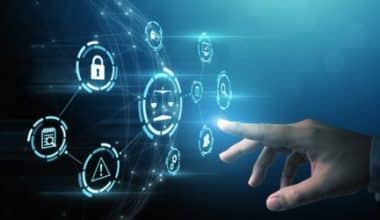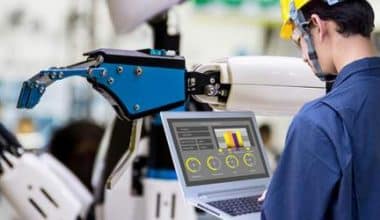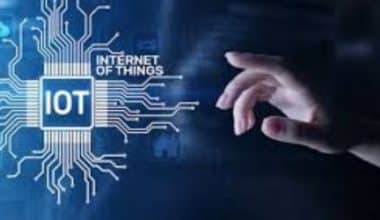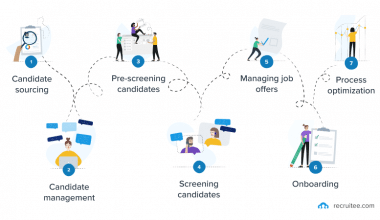Recently, data is generated at an unprecedented pace, and as a result, traditional cloud computing models face significant challenges. There is a need for faster processing, reduced latency, and enhanced privacy and this has led to the emergence of a revolutionary paradigm known as edge computing. But what exactly is it, and why does it matter? Let’s find out below!
What Is Edge Computing?
Edge computing refers to a distributed computing paradigm that brings computation and data storage closer to the location where it is needed, typically near the edge of the network or closer to the devices generating or consuming data. In edge computing, processing, and analysis of data occur at or near the source, rather than relying on a centralized cloud infrastructure.
Traditionally, in a cloud computing model, data from various devices or sensors are sent to a centralized data center or cloud server for processing and analysis. However, edge computing aims to overcome the limitations of cloud-centric approaches, such as latency, bandwidth constraints, and reliance on a stable network connection.
By moving computation closer to the edge of the network, it enables real-time data processing, faster response times, reduced network traffic, and improved reliability. It is particularly beneficial for applications that require low latency, such as Internet of Things (IoT) devices, autonomous vehicles, industrial automation, augmented reality, and remote monitoring.
In an edge-computing architecture, edge devices, such as gateways, routers, or edge servers, are deployed near the data sources. These devices perform local data processing, filtering, and analysis, reducing the amount of data that needs to be sent to the centralized cloud infrastructure. The processed data or relevant insights can then be sent back to the devices or transmitted to the cloud for further processing, storage, or long-term analysis.
Edge computing has several advantages:
#1. Reduced Latency
By processing data locally at the edge, real-time applications can achieve faster response times, minimizing the delays caused by transmitting data to a remote cloud server.
#2. Bandwidth Optimization
Aside from reducing latency, it also reduces the amount of data that needs to be transmitted over the network, optimizing bandwidth usage and reducing the costs associated with data transfer.
#3. Improved Reliability
Edge devices can continue to operate and process data even in situations where the network connection is unreliable or temporarily disrupted. This enhances the overall system reliability and availability.
#4. Enhanced Data Privacy and Security
Since sensitive data can be processed locally, edge computing mitigates privacy concerns and security risks associated with transmitting data to external servers.
#5. Scalability
It can also distribute the processing load across multiple edge devices, enabling scalable and efficient handling of large volumes of data.
Why is Edge Computing a Critical Technology Shaping the Future of Computing?
Edge computing is a critical technology shaping the future of computing due to several reasons. Firstly, it addresses the limitations of traditional cloud computing models, which often struggle with latency and processing speed. It brings computation closer to the data source and also reduces the time it takes for data to travel back and forth between devices and remote data centers. This enables real-time data processing, analysis, and decision-making, which is essential for applications such as autonomous vehicles, industrial automation, and real-time monitoring systems.
Secondly, it enhances data privacy and security. With sensitive information processed and stored locally, there is reduced reliance on transferring data to remote servers. Generally, this minimizes the risk of data breaches and unauthorized access. This aspect is particularly important in industries such as healthcare, finance, and government, where data confidentiality is paramount.
What Is an Example of Edge Computing?
An example of edge computing is the use of smart home devices. In a traditional setup, data from these devices, such as thermostats, security cameras, and voice assistants, would be sent to a central server or cloud for processing. However, with edge computing, the processing and analysis of this data can occur locally on the devices themselves or on nearby edge servers.
For instance, a smart thermostat equipped with this computing capability can collect temperature and occupancy data from sensors within a home and make real-time decisions on how to regulate the temperature without relying on a distant server. This allows for faster response times, reduced latency, and greater efficiency in managing the heating and cooling systems within the home.
Another example is autonomous vehicles. Self-driving cars generate an enormous amount of data from various sensors, including lidar, cameras, and radar. Processing this data in real time and making split-second decisions is crucial for the safe operation of autonomous vehicles.
It enables these vehicles to perform local processing and analysis of sensor data, reducing the reliance on a remote cloud server and ensuring rapid response times for critical tasks like object detection and collision avoidance.
What Are the Key Characteristics of Edge Computing?
The key characteristics are as follows:
#1. Proximity
It brings computational resources and data processing closer to the edge of the network, near the point of data generation or consumption. The good thing about this is that proximity reduces latency and enables real-time or near-real-time processing.
#2. Distributed Architecture
It involves a decentralized architecture where computation, storage, and analytics capabilities are distributed across edge devices, edge servers, or fog nodes. This distribution improves reliability, fault tolerance, and scalability.
#3. Localized Data Processing
It emphasizes processing and analyzing data locally at the edge rather than relying on a centralized cloud server. This localized processing reduces the need for data transmission, saving bandwidth and reducing reliance on constant internet connectivity.
#4. Real-Time or Near-Real-Time Processing
It enables real-time or near-real-time analysis and decision-making. This is crucial for applications requiring low latency, such as autonomous vehicles, industrial automation, or remote monitoring systems.
#5. Bandwidth Optimization
It optimizes network bandwidth usage by filtering, summarizing, or pre-processing data at the edge before transmitting it to the cloud. This reduces the volume of data transmitted, saving bandwidth and reducing costs.
#6. Enhanced Security and Privacy
It improves security and privacy by keeping sensitive data local or within a specific geographic area. Instead of transmitting data to the cloud, where it may be exposed to potential threats, it allows for local processing and storage of sensitive data.
#7. Offline Capabilities
It enables devices and applications to operate offline or with limited connectivity. Local processing and storage capabilities allow devices to continue functioning even when internet connectivity is intermittent or unavailable.
#8. Scalability and Flexibility
It offers scalability and flexibility by allowing for the deployment of edge devices or servers based on specific requirements. Additional computational resources can be added at the edge as needed, enabling rapid scaling of edge computing infrastructure.
What Is the Main Purpose of Edge Computing?
The main purpose of edge computing is to bring computing resources and data processing closer to the source of data generation, rather than relying solely on distant cloud servers or data centers. It aims to address the limitations of traditional centralized computing architectures by distributing computation, storage, and analytics capabilities to the network edge, which is closer to where data is created or consumed. One can also say it exists to improve the efficiency, performance, and responsiveness of applications and services by decentralizing computation and bringing it closer to the edge of the network.
What Is Another Word for Edge Computing?
Another word or term that is often used interchangeably with “edge computing” is “fog computing.”
What Is Edge Computing Technology
Edge computing technology refers to the set of technologies and approaches used to enable edge computing. It encompasses a range of hardware as well as software components that facilitate the processing, storage, and networking capabilities at the network edge. The following are some of its key components:
#1. Edge Devices
These are the physical devices located at the network edge, such as sensors, gateways, routers, switches, or edge servers. They collect, process, and transmit data from various sources.
#2. Edge Servers
These are computing devices that are deployed at the edge of the network to provide computational power, storage, and local data processing capabilities. Edge servers can be located in data centers, on-premises, or in distributed locations.
#3. Edge Operating Systems
These are specialized operating systems designed to run on edge devices or edge servers. They are optimized for low power consumption, resource efficiency, and real-time processing. Examples include Ubuntu Core, Windows 10 IoT Core, or Wind River’s VxWorks.
#4. Edge Analytics Software
This software enables real-time data analysis and decision-making at the edge. It may include machine learning algorithms, artificial intelligence models, or data analytics frameworks. Edge analytics software allows for local processing and insight generation without relying on a centralized cloud server.
#5. Edge Networking
This refers to the networking infrastructure that connects edge devices and servers. It may involve technologies such as edge routers, edge switches, or software-defined networking (SDN) solutions. Edge networking enables efficient data transmission and communication between devices and the cloud.
#6. Containerization and Virtualization
These technologies allow for the encapsulation and isolation of software applications and services, making it easier to deploy and manage edge computing environments. Containers and virtual machines can be deployed on edge devices or servers to run applications and services in a modular and scalable manner.
#7. Edge Management and Orchestration
These tools and platforms help manage and coordinate the deployment, configuration, monitoring, and maintenance of edge computing infrastructure. They provide centralized control and visibility over distributed edge devices and services.
What Are the Types of Edge Computing?
There are several types or categories of edge computing that can be classified based on the location and deployment of edge resources. Below are a few examples;
- Edge Devices
- Edge Servers
- Fog Computing
- Cloudlet Computing
How Does Edge Computing Work
Edge computing works by decentralizing computational resources and data processing to the network edge, closer to where data is generated or consumed. Below is an overview of how it typically works:
#1. Data Generation
Data is generated from various sources, such as sensors, IoT devices, or user interactions with edge devices like smartphones or smart appliances. This data can include sensor readings, video streams, or user inputs.
#2. Data Collection and Filtering
Edge devices or gateways collect the data from the sources and perform initial filtering or preprocessing to reduce the volume of data that needs to be transmitted. This step helps optimize bandwidth usage and reduce latency.
#3. Local Data Processing
Edge devices or edge servers perform local processing and analysis of the collected data. This can involve running algorithms, applying machine learning models, or executing specific tasks to extract insights, make decisions, or trigger actions based on the data.
#4. Decision-Making at the Edge
It enables real-time or near-real-time decision-making at the edge. By processing data locally, edge devices can quickly respond to events or conditions without relying on a distant cloud server. This is particularly important for time-sensitive applications such as autonomous vehicles or industrial automation.
#5. Data Transmission
After local processing and decision-making, edge computing systems transmit relevant or summarized data to the cloud or other centralized systems. This can involve sending processed data, alerts, or aggregated results for further analysis, storage, or long-term processing.
#6. Cloud Integration
Edge computing often involves integration with cloud-based systems or services. Cloud platforms can be used for long-term storage, advanced analytics, machine learning training, or providing additional computational resources when needed. Edge devices can leverage cloud resources for tasks that require extensive computing power or historical data analysis.
#7. Management and Orchestration
Edge computing infrastructure requires management and orchestration to ensure proper deployment, configuration, monitoring, and maintenance of edge devices, edge servers, and associated software components. This can involve centralized management platforms or tools that provide control, visibility, and automation for its deployments.
What Is Edge Computing Accenture
Edge computing refers to the practice of processing data near the source, or “edge,” where it is generated rather than sending it to a centralized cloud or data center. Accenture is a global professional services company that provides a wide range of consulting, technology, and outsourcing services. They work with organizations to help them leverage edge computing technologies and strategies to improve their operations, enhance their digital capabilities, and drive innovation.
Accenture recognizes the potential of edge computing in enabling real-time data processing, reducing latency, improving network efficiency, and enabling new use cases across various industries. They offer services related to edge computing, including strategy development, architecture design, implementation, and integration. Accenture assists clients in assessing their edge computing requirements, identifying appropriate edge infrastructure, optimizing network connectivity, and developing edge-enabled applications.
By leveraging edge computing, organizations can enhance their ability to collect, process, and analyze data closer to the point of origin, enabling faster insights and responses. This is particularly valuable in scenarios where real-time decision-making is critical, such as autonomous vehicles, smart cities, industrial IoT, healthcare monitoring, and remote asset management.
Accenture’s expertise in edge computing allows them to support clients in adopting this technology effectively, leveraging its potential to drive digital transformation, improve operational efficiency, and create new business opportunities.
Edge Computing vs Cloud Computing
Edge computing and cloud computing are two distinct paradigms in the field of computing, each serving different purposes and addressing specific requirements. The following are the key differences between edge computing and cloud computing:
#1. Proximity to Data and Processing
In edge computing, data processing occurs closer to the source or “edge” of where it is generated, typically at or near the devices or sensors. This proximity enables real-time processing, reduces latency, and minimizes the need for data transmission to centralized data centers. In contrast, cloud computing involves processing and storing data in remote data centers that are often geographically distant from the devices generating the data.
#2. Data Volume and Bandwidth
It is suited for scenarios where large volumes of data are generated but it is impractical or inefficient to transmit all of it to the cloud due to limited bandwidth or cost considerations. Instead, it filters and processes data locally, transmitting only relevant information or aggregated insights to the cloud. Cloud computing, on the other hand, is well-suited for applications that require massive storage capacity and extensive data processing capabilities.
#3. Latency and Real-time Processing
Edge computing aims to minimize latency by processing data locally, enabling real-time or near-real-time analysis and decision-making. This is crucial for time-sensitive applications such as autonomous vehicles, industrial automation, and healthcare monitoring. In cloud computing, data has to be transmitted to remote data centers, which introduces latency, making it less suitable for applications that demand immediate processing.
#4. Scalability and Resource Availability
Cloud computing offers virtually unlimited scalability and computing resources. Organizations can easily scale up or down their computing capacity based on demand, paying for resources as needed. In edge computing, the available computing resources are limited to the edge devices themselves or a localized infrastructure, which may have constraints in terms of processing power, storage, and network capacity.
#5. Network Dependency
Cloud computing relies heavily on network connectivity to transmit data to and from remote data centers. In edge computing, the dependency on the network is reduced as data processing occurs locally. This can be advantageous in scenarios where network connectivity is intermittent, unreliable, or costly.
#6. Data Privacy and Security
Edge computing can enhance data privacy and security by keeping sensitive data local, reducing the risk of unauthorized access or data breaches during transmission to the cloud. Cloud computing, on the other hand, requires careful consideration of data security measures as data is stored and processed in remote data centers managed by cloud service providers.
Is Tesla an Edge Computing?
Not entirely. Tesla, the electric vehicle and energy company, utilizes edge computing in its vehicles, but it is not primarily considered an edge computing company. Edge computing plays a role in Tesla’s vehicles to enable real-time data processing and decision-making, but Tesla’s core business revolves around electric vehicles, renewable energy, and related technologies.
Is Edge Computing a Hardware or Software?
Edge computing encompasses both hardware and software components. It refers to a distributed computing paradigm that combines hardware infrastructure and software applications to enable data processing and analysis at or near edge devices or sensors.
- CLOUD COMPUTING: Definition, Types, Pros, Cons & PDF (Detailed 2023 Guide)
- TOP CLOUD SERVICE PROVIDERS IN 2023: Ultimate Guide
- The Importance of Internet Speed for Online Gaming
- CLOUD ENGINEER: Definition, Duties, Jobs, Salary & How to Become One
- VOICE ASSISTANTS: Everything To Know About Voice Assistants
- Gps-tracking-software






